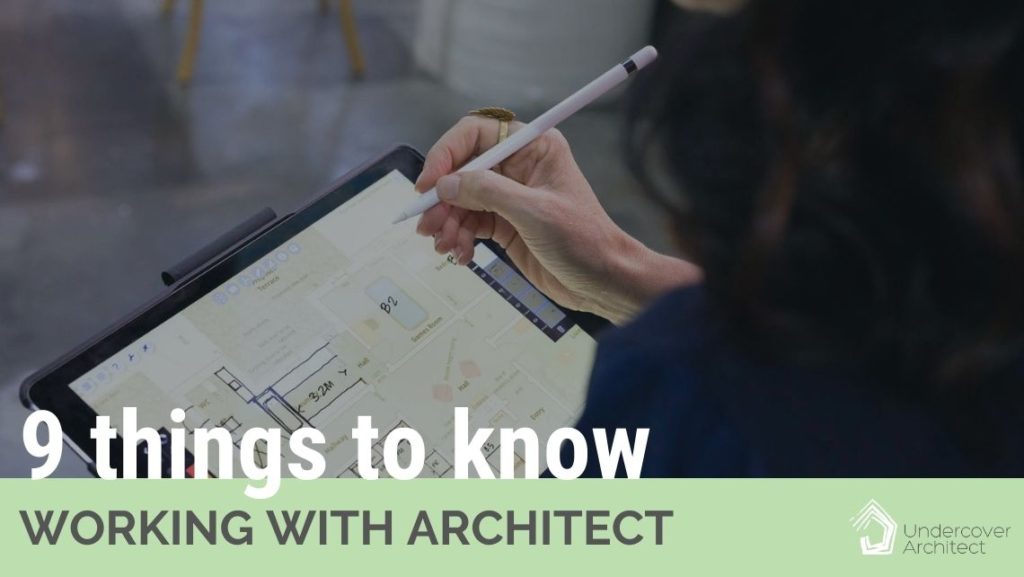
Are you working with an architect (or any designer) in your new home or renovation project?
Or planning to work with an architect?
Things can go wrong in a designer-client / architect-client relationship.
However, there’s also a lot of misconceptions about working with an architect.
AND there’s also key ways you can prevent mistakes and manage your risk before you get into trouble!
This ‘9 things to know about working with an architect’ will help demystify the process.
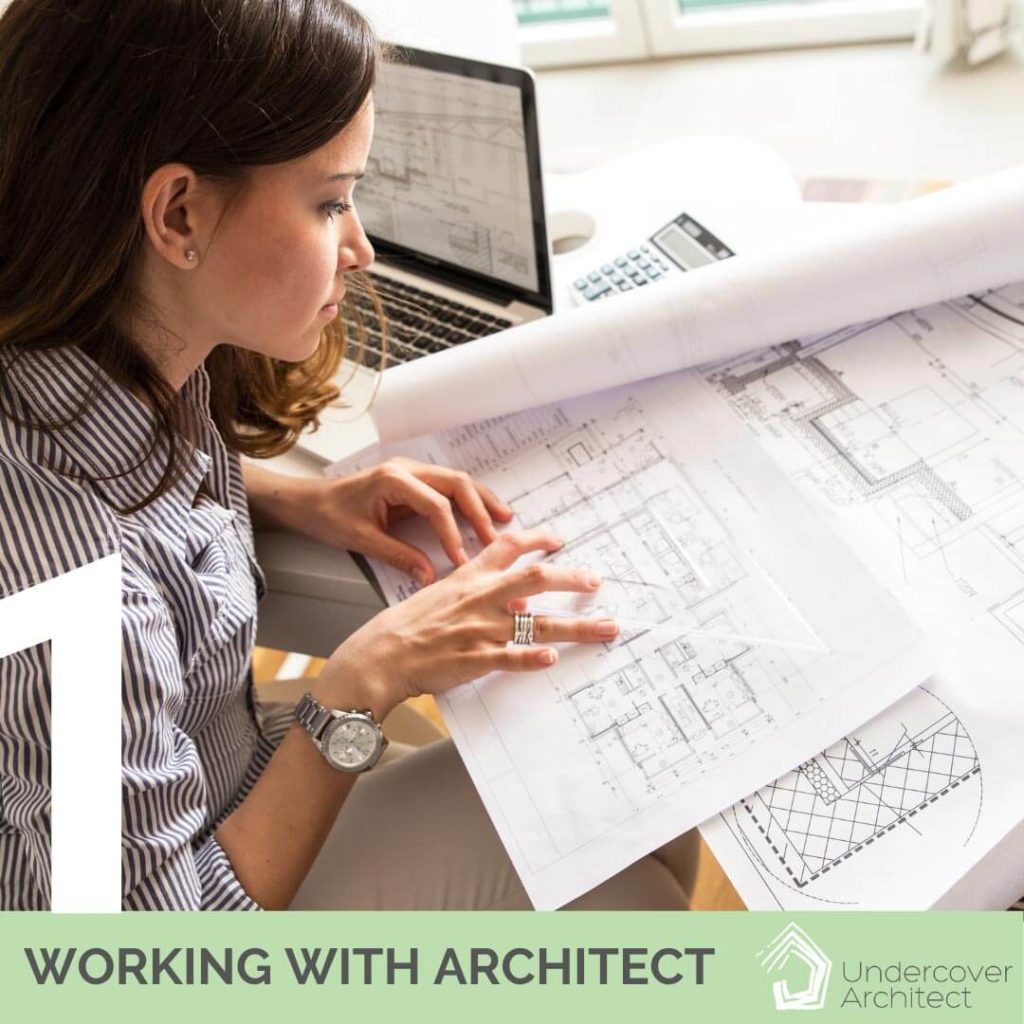
NOTE: I will never tell you that you have to use an architect. I’m a big believer in you finding the right designer for you, whoever that is. However, if you are going to use one, there’s some key things to know. That’s what this #9thingstoknow is all about.
#1 Is your architect really an architect?
One of the big differences between architects and other design professionals is this:
To call yourself an ‘architect’ and describe your work as architectural design, or architectural services, you have to be registered as an architect with the Board of Architects in your state.
To get registered, you have to do a recognised architectural university degree, complete a minimum number of years of work inside the industry, and then pass a written exam and an interview. And afterwards, you have to do continuing professional development hours each year.
This isn’t something the industry has made up and simply uses internally. There is a Code of Conduct, and certain requirements actually captured in a Government Act.
No other design professional has this level of required performance in order to use the title of their profession. Architects have greater legal liability, and a much higher onus put on them than building designers or draftspeople do.
However, that doesn’t mean they’re necessarily going to be the right professional for you. But, if you do want an architect, make sure you’re actually getting an architect. Because there’s lots of people out there who will say “I did a degree in architecture and didn’t bother getting registered, but I’m the same anyway.” And there’s others who will call themselves an architect even if they are nowhere near.
That being said … just because someone has been able to jump through all these hoops to acquire the title, does not make them great at what they do.
As with any industry, there are some architects who:
> don’t know how to design well
> don’t do a great job of taking care of their clients
> struggle with clear and effective communication
> find budget management difficult
> don’t understand construction very well either
So, it’s essential you still do your homework to review and vett the design professionals you’re considering for your project – whatever their title.
Don’t assume that just because someone is an architect, they’ll be able to perform to the gold standard of home design and industry performance. Get yourself informed about how to find a great professional, and then keep them accountable as they work with you on your future home.
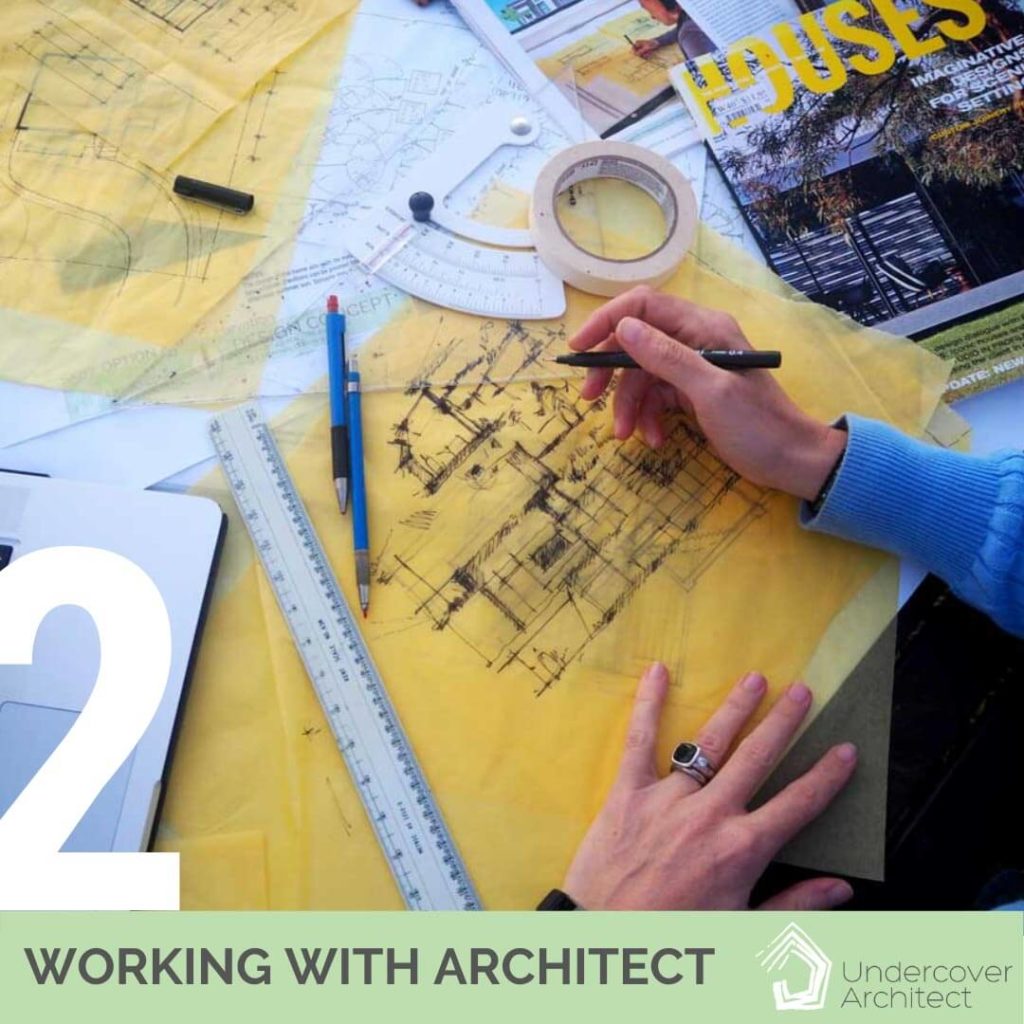
#2 Architects are not necessarily more expensive to use
There’s an assumption out there that if you have a high end project to do, or something particularly complex or big budget, that you use an architect.
And with that assumption goes, that if it’s a smaller project, or ‘something simple’, then you should a building designer, or even just a draftsperson.
And in fact, many homeowners say “I know what I want – I just need someone to draw it up” (and then, interestingly, get frustrated that the draftsperson doesn’t ‘add’ anything in design input or suggested ideas).
This is the thing though: architects are NOT always more expensive.
Design is not something limited to a particular professional. And in fact, you can go to a building designer, a builder, an architect, an interior designer … all for that initial design creation for your future home.
However, if you’re wanting good quality design input in your project, and you’re choosing one of these professionals purely based on budget, then you may be misguided.
I’ve seen building designers charge more than architects.
I’ve seen interior designers charge more than architects.
Architects do not control the ‘most expensive fees’ part of the market – it is REALLY a case of the individual or company you use, not which profession.
Remember too, that each will offer a different scope of works, a different amount of involvement and coordination, and a different level of expertise in structural knowledge, spatial and materials understanding, and the logistics of town planning, approvals, etc.
So, when comparing fees and costs, ensure you are comparing apples with apples.
Many homeowners have been caught out, thinking they were saving money on design fees, only to incur extra expense during their projects due to gaps in necessary steps or guidance.
Check this podcast episode for more information on what should be in ANY fee proposal you receive from a designer to help manage your risk [it’s Episode #74] >>> https://undercoverarchitect.com/podcast-what-should-be-in-architect-quote/
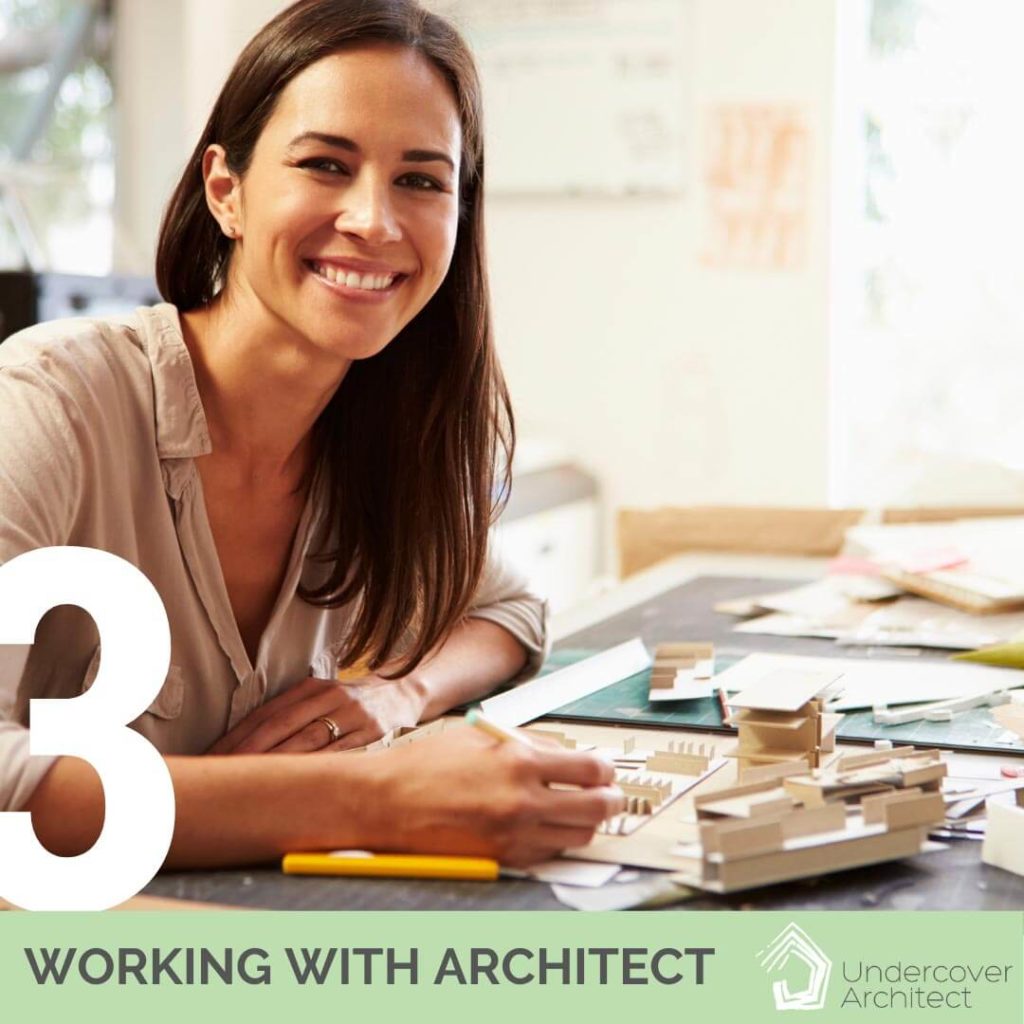
#3 They may not know what your project will cost
There’s a mistaken perception that all architects (and in fact all designers) will know what your project will cost to build or renovate.
This leads a lot of homeowners into trouble, as they rely on costing advice from their architect or designer during the design phase … only to be sorely disappointed when they go to tender, and find that the home design they’ve fallen in love with exceeds their budget.
The costing feedback being given by your architect is only meaningful if:
- they’re doing lots of finished projects like yours
- they’re collecting regular data on what those projects actually cost to complete
- they’re keeping up to date with industry trends and costs
I know of architects who have YEARS of data on their finished projects, and can identify costs on a $/m2 as a result … but only if you’re doing a project like their past projects.
The problem is though, that many architects in private practice don’t get to see a lot of their homes built per year. And with costs moving at the rate they do, it’s super difficult for them to have a good handle on what your project will cost to do.
In addition, architects should only be providing “opinions of probable cost” which is not a cost estimate, or something to be solely relied upon.
I also see architects and other designers get budget information at the beginning of a project, and never discuss it again with the client. Or, they’ll simply estimate a $/m2, and keep a running tally of areas on the drawings to use that $/m2 to track the budget overall.
If the $/m2 isn’t accurate in the first place, or you have specific challenges with your site not reflected in that $/m2, or it’s not being updated over the 6 to 12 months you’re designing … it’s a dangerous way to estimate your costs.
The best (and frankly, only) way to get accurate costing input during your design phase? Bring a builder on board your design team, and pay them as a consultant to work with your designer, advising on buildability and cost along the way. That way, your design will develop in alignment with your budget.
Don’t leave it only up to the architect or any other designer to tell you what your project will cost.
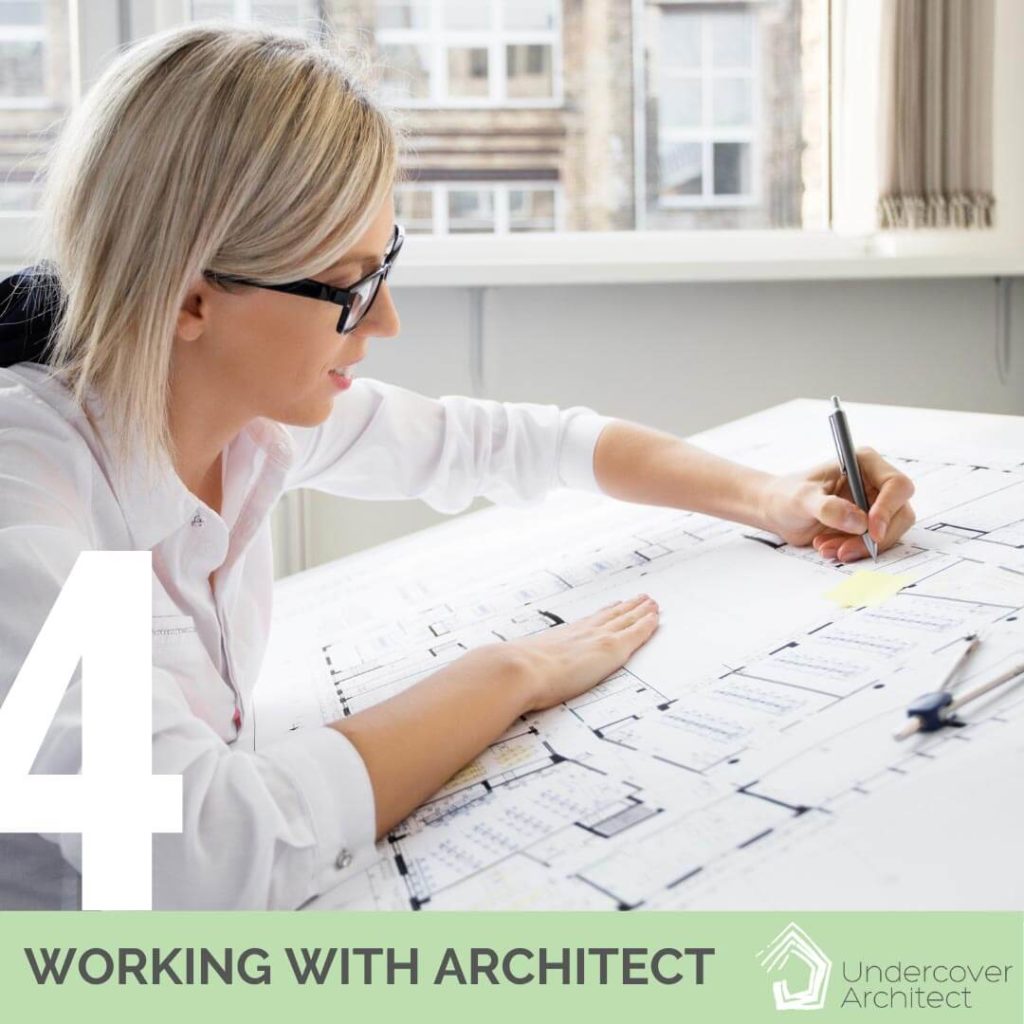
#4 They should prioritise your needs and wants, and interpret them to meet your budget and site.
The whole idea reason you hire an architect – or any designer – is because they can expand what is possible in the vision you have for your future home.
They bring their expertise, their experience, their training, their know-how, to your project … and it means that whatever you had planned (and whatever you wanted to spend on it) is maximised to its fullest potential. Often beyond what you believed was possible at all.
And given the amount of training, education, and experience architects usually have, this is especially true for that part of the profession.
There is a lagging perception (gratefully being blown up by those in the industry totally fed up with it), that the architect (or ‘starchitect’) is a gifted artist realising their vision. And you the client, are merely their patron, like some renaissance ideal. And you’re totally lucky that they’ve deigned to do your project. You just have to stand back and let the artist do their work, and spend your money how they see fit.
It’s how Frank Lloyd Wright worked. It’s how many senior architects have worked. And have also built a reputation and portfolio of award-winning buildings on it too.
This is not how the architect-client relationship should be AT ALL.
I’ve worked with homeowners on their home designs, renos and new builds, and there’s a beautiful moment at the end where they say “this is better than I ever expected or envisaged it could be”. (Personally, that’s always been my aim as an architect).
And that’s also the feedback I hear from my members who’ve had similarly great experiences in working with their own architects and designers.
If it’s not going well, you’re not being listened to, you feel you’re being pushed to solutions you don’t agree with, or there’s any part of the relationship that feels your priorities are not being prioritised … then speak up.
Architects are not mind-readers. They’re also not delicate artists you’ll personally offend with your feedback. Muster the courage to be honest and frank with them.
Open communication is always best in these working relationships. It’s your home, after all.
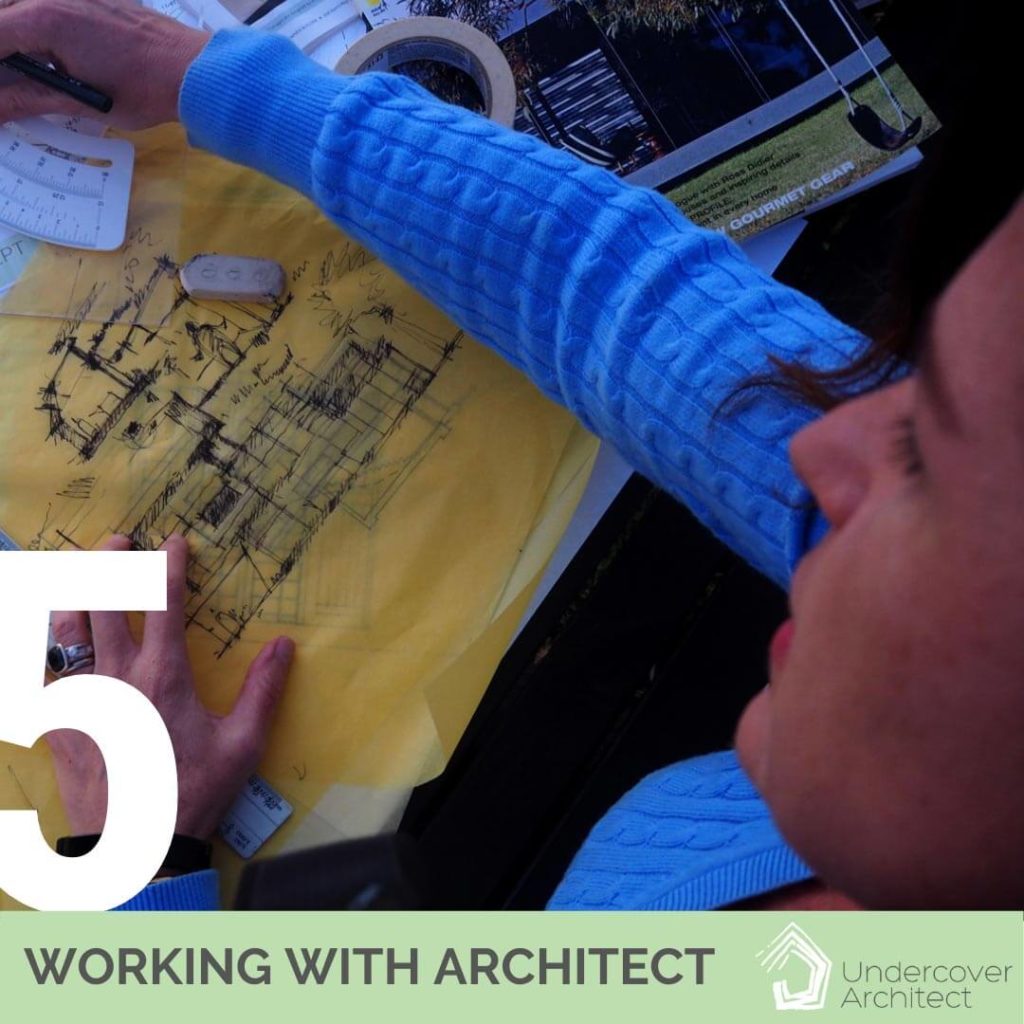
#5 They’re not all great communicators, and they can struggle to say ‘no’.
Communication is not a skill trained in architectural university degrees, which is a shame given how incredibly pivotal it is to the role.
And so, some architects, and designers, are simply not great communicators. They’re not great at explaining their ideas, showing they understand a client’s brief, or in helping clients understand the process of working with them.
Architecture can also have its own language that can be bewildering to the uninitiated client. And architects can struggle to speak plainly about their work as well. (Read any awards submission written by an architect, and you’ll know what I mean).
Note to architects: speaking this way about your work is alienating clients and really doesn’t serve them or the industry.
I also see some architects and designers really struggle to push back on their clients’ requests and wishes.
I often joke that, because I’m a mum, I find it easy to say ‘no’. But it’s actually a really critical skill when any architect is working with a client.
Your job as a client is to determine your dreams, desires and hopes for your project – as well as figure out what you want to spend on them.
And one of the architect’s many jobs in any project is to keep their client on track. To understand the goals and vision for the project (and how it fits into the client’s overall lifestyle and future plans), and help them have clarity as they move through the countless decisions and steps any project requires.
And that will sometimes mean saying ‘no’ … or ‘that’s not in keeping with what you said you wanted – has your original vision / brief / goal changed?”
It’s that last one that lots of architects struggle with.
Because unless you’re naturally good at communication, or experienced at helping clients navigate their projects AND you have their trust and confidence as well, then it can be really difficult to keep guiding clients, and have them listen to your advice and recommendations.
So architects: tread the delicate line between expanding the project possibilities, and honouring the client’s brief and budget.
And clients: look for architects who communicate well.
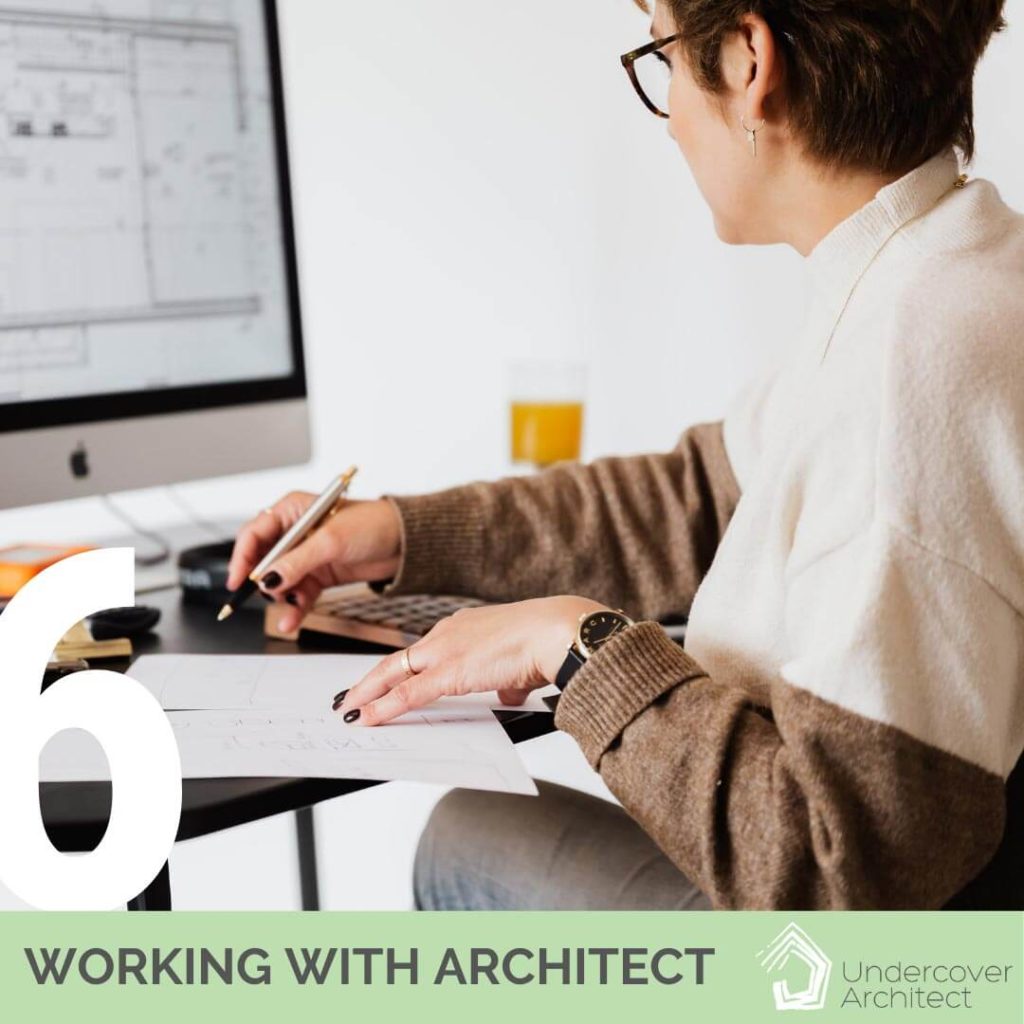
#6 They can work in part or all of your project, from site selection through to interior design and completion.
Architects can be a great team member for your project. However, many homeowners believe that, if they’re going to use an architect, they have to use them for their entire project … which can mean more in professional fees than they’re willing to pay.
In working with an architect, there are several stages you can work with them in:
- Schematic or Concept Design
- Design Development
- Approvals
- Documentation
- Tendering (if a builder is not part of the design team)
- Contract Administration
(Plus all required consultant coordination too).
Some architects will insist on only working clients through ALL stages.
Yet, other architects are willing to help with specific stages in your project – which can be a great way to access design expertise and advice to enhance your future home.
Some areas their help can make a big difference in your project:
- site selection to ensure you understand the constraints and opportunities before buying a block of land
- reviewing potential renovators, so you can understand what’s possible and the potential costs involved
- concept design, to get high level design input into the strategy and foundation of your design approach
- interior design, which some architects will happily include in their services (which can be great for fully integrating the architectural and interiors solution)
- even a consultation to set the right strategy at the outset
Or the whole kit and kaboodle.
If you’re using an architect for partial services, be sure you discuss copyright, and how you’ll continue working with other professionals to get the design developed and documented for approvals and construction. The architect owns the copyright, and so this can prevent you from taking it elsewhere unless you’ve discussed and agreed it first.
And if they’re just doing the design concept, be sure it’s still done with the understanding of site rules, soil conditions and planning restrictions – otherwise the investment in their design may be pointless (because it can’t get approval or suit your site).
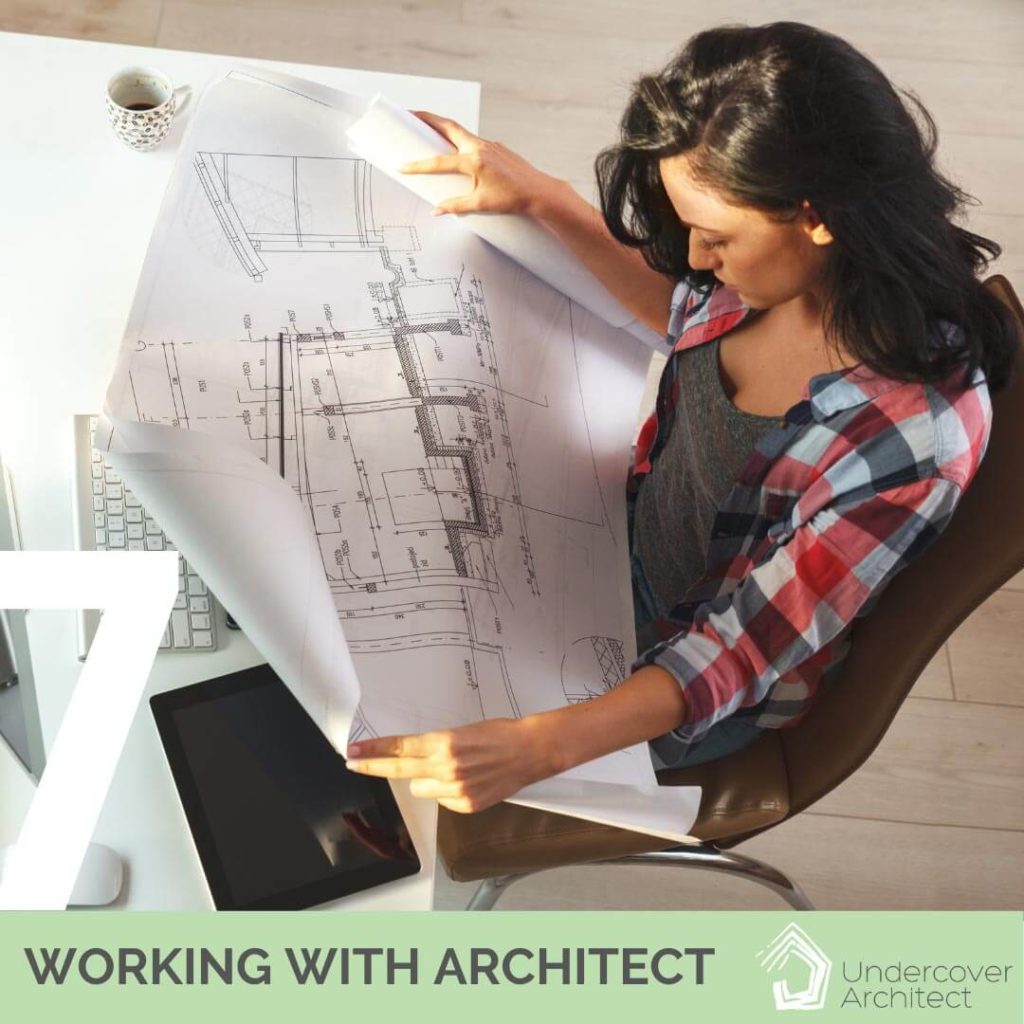
#7 They’re not all going to use your home as a portfolio project
One of the challenges that exists in the industry of home design – be it for architects, building designers, interior designers, etc – is that you, the homeowner, keenly look through their portfolio of finished (beautifully styled and photographed) projects to determine their potential as YOUR designer.
And so, many successful designers’ websites and social media accounts become a photo gallery of homes, styled images, and pristine projects.
Plus, industry awards are generally set up to reward the finished, photographed, project as well.
(I can’t think of awards that celebrate ‘happiest client’ or ‘was delivered on budget and on time’ when it comes to architecture and design!!)
So, when, as an architect or designer, your business card IS your finished, photographed, project …
And that’s how you generate future work, plus show what you are capable of doing …
Then, you’re going to care about what those finished, photographed projects look like, and what you publish (and don’t). And this is why there are many architects who insist on ONLY working with clients the whole way through their project.
BUT … then you, as the homeowner, can (understandably) fear that the home you’re dreaming of and funding with a lifetime’s savings, or a 30 year mortgage, is simply a vehicle for future portfolio photographs. And as a result, you won’t get what you want, or will be over-ridden at every turn.
With great, collaborative designers and architects, this is NOT the case.
But it’s up to you, as the homeowner, to ensure you interview and vett architects and designers to find the right one for you.
How do you do this? Well, there’s lots of resources on Undercover Architect to help you … but it really comes down to:
- Looking for a designer / architect who does work like the result you’re envisaging
- Seeing how they communicate, listen, guide you – right at the start
- Reviewing for personal fit, shared values, and good connection
- Being REALLY clear about your brief, your ideas and your goals for your project.
Don’t hire a star-chitect with a reputation for railroading clients, and be surprised when they do it to you.
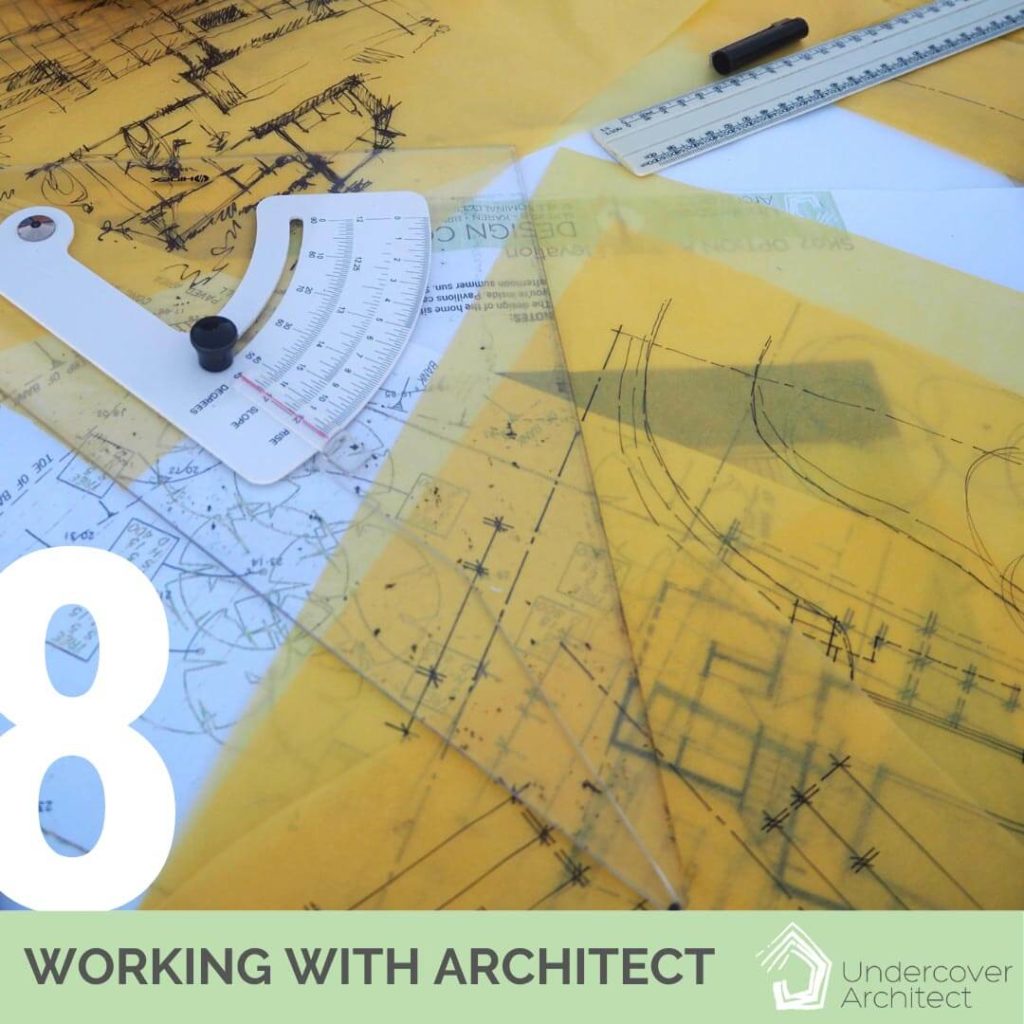
#8 Establish timelines, deliverables, scope and inclusions
A key mistake to avoid when hiring a designer or architect happens right at the start.
It’s when you, as the client, are not told timelines, deliverables, scope or inclusions.
And so, you enter your project, not really sure of what to expect. Plus you have no recourse when you don’t hear from your architect for weeks (or months), or you find yourself being told you’ll be charged extra for changes to drawings or extra documentation.
With any designer you’re planning on working with (architects included), these are the things to know BEFORE you sign an agreement with them:
- how long will the process take?
- when and where, and how often will you meet?
- how many reviews of your design are included in your fee?
- what is expected of you for turnaround your reviews and feedback to keep workflow happening smoothly
- what will you be getting (deliverables) in drawings, plus other items (models? 3D renders? walk-throughs?)
- how will they work with you through the project – and what other responsibilities will they take on?
- just what is included, and not included, in your fee?
These are just some of the items to check in your agreement (and you can find out more by heading to our podcast episode on what should be in an architects quote).
The way you avoid drama and heartache in your relationship with your architect and designer is by managing your risk before you even start.
Once inside a binding legal agreement, it can be much harder to deal with.
You may have unwittingly agreed to paying huge penalties if you don’t want to work with them anymore. You may have committed to having to use them the whole way through construction. You may have agreed to extra fees for any additional meetings or drawings or consultant coordination.
Homeowners tell me they were just ‘too trusting’ and ‘naive’ when they signed. You don’t have to be. These agreements can be for tens of thousands, right through to hundreds of thousands of dollars – and can last sometimes as long as two or three years. Know what you’re agreeing to before you sign.
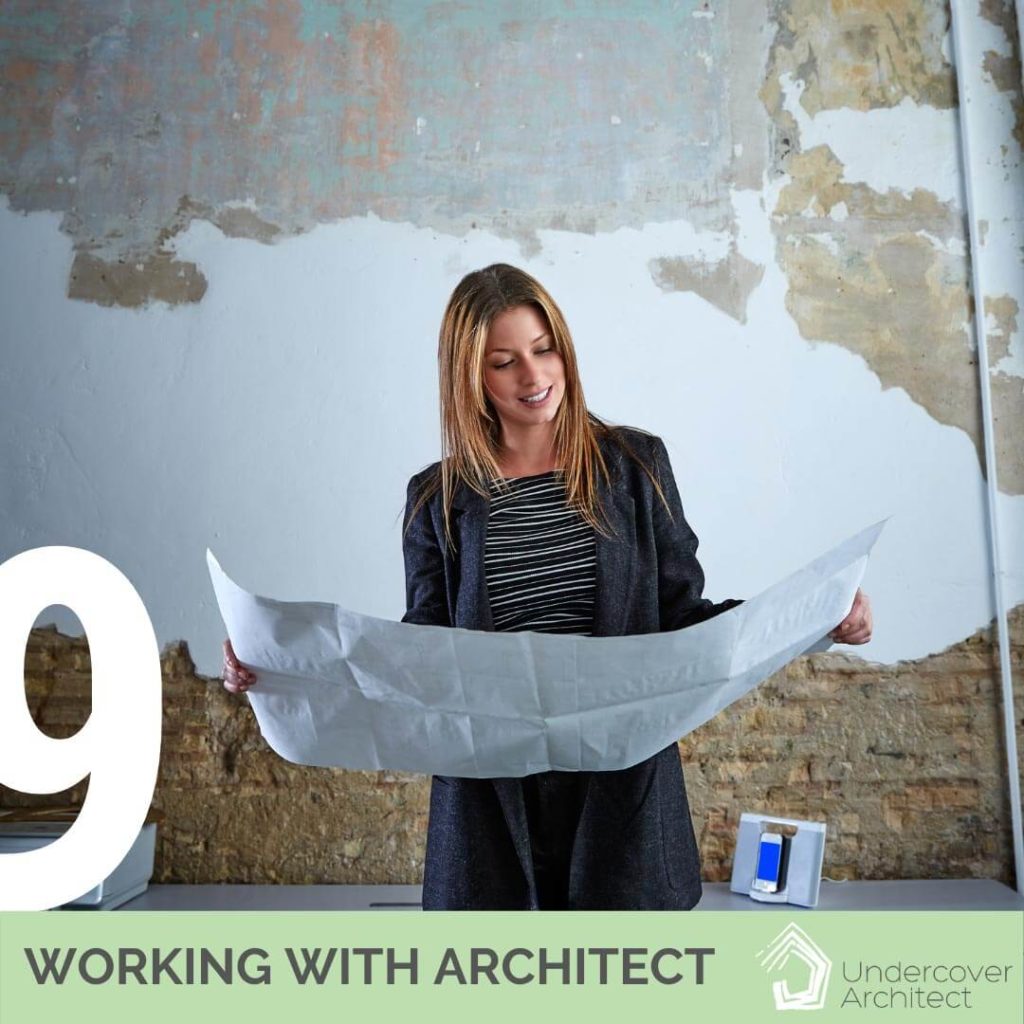
#9 Listening and learning works both ways
Now, across these 9 things to know about working with an architect (or any designer), I’ve shared a lot about what you, the homeowner and client, can do to protect yourself, avoid working with a starchitect, and find a great architect who’ll guide and support you in creating an amazing home for your budget and brief.
But this is the thing:
You, as the client, have responsibility here too. Because it works both ways.
There are a few things I regularly see homeowners regularly do that jeopardises their project, and makes it difficult for their architect to provide them great service, or a great outcome.
These things are not limited to, but can include:
- Lying about their budget (incase the architect just goes and spends it all)
- Ignoring the architect’s recommendations that their wishes will cost more than their budget
- Bullying the architect because they’re worried about being taken advantage of, so they get on the front foot by being forceful and challenging to work with collaboratively
- Not speaking up when they’re frustrated or disappointed, letting molehills turn into mountains, and then it all coming to a crunch at a critical point (when it’s then extra in fees and times to rework and change).
Your goal as the homeowner is to do thorough due diligence to find the right designer for you, with experience in projects like yours, and a tested, proven system of taking you (confidently) through your project journey.
And then to work with them in an honest, open and transparent way that creates a fantastic collaborative relationship where your project is king, and your design and budget can be maximised to its fullest potential. Where you can trust their advice, act on their recommendations, and be led by their expertise.
And when you listen to their guidance, learn along the way, and do what you need to do to be a great client, you’ll completely expand what’s possible for your budget, your site and your future home.
This is how you enjoy your project.
So, what are you doing, as a client and homeowner, to put yourself in the best position possible, to be educated and informed – and to find the right architect or designer for you?
FOR MORE HELP IN WORKING WITH AN ARCHITECT OR DESIGNER, HEAD TO THESE RESOURCES:
Want to design a home without using an architect? Learn the 3 things to include in your home design process >>> LISTEN TO THIS SPECIAL EPISODE HERE [#150]
Not all designers are created equal. Here’s how to choose the right designer for you >>> LISTEN TO EPISODE 01 [#73]
Learn more about what an architect does in this interview with award-winning architect, Shaun Lockyer >>> LISTEN HERE
If you’re not sure what a Building Designer does (and how they differ to an architect), this interview with Aaron Wailes will help >>> LISTEN HERE
How much do architects charge and why do they charge percentage fees? >>> READ MORE HERE
Working with an architect means creating a design that will blow your budget, doesn’t it? Well – here’s how to avoid that >>> READ MORE HERE
Here’s what to expect when working with an Interior Designer >>> Interior Design Basics Season – LISTEN TO SEASON 11 EPISODE 02 [#135]
Bad architect and bad service? Here’s what to do >>> READ MORE HERE
IMAGE SOURCES:
Images are sourced from Canva or are of me!
 With over 30 years industry experience, Amelia Lee founded Undercover Architect in 2014 as an award-winning online resource to help and teach you how to get it right when designing, building or renovating your home. You are the key to unlocking what’s possible for your home. Undercover Architect is your secret ally
With over 30 years industry experience, Amelia Lee founded Undercover Architect in 2014 as an award-winning online resource to help and teach you how to get it right when designing, building or renovating your home. You are the key to unlocking what’s possible for your home. Undercover Architect is your secret ally
Excellent article—thorough, detailed questions and suggestions offered; explains the profession and credentials to look for when hiring an architect, offers audio recordings with more information. Just am impressed with all the information you make available to keep a homeowner on track and out of trouble. Very much appreciate the time you took to write and make this available for free.
Hi Yvonne, thank you for supporting UA. We’re glad that this was helpful for you!